
Imperial Japanese Army Uniforms
Encyclopedia
Imperial Japanese Army Uniforms tended to reflect the uniform
s of those countries who were the principal advisors to the Imperial Japanese Army
at the time.
of the American Civil War
.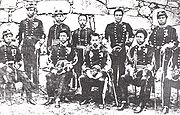
M1842/M1856 dunkelblau uniform, the dark blue single-breasted tunic
had a low standing collar and no pockets. It was worn with matching straight trousers
and a kepi
(red for Imperial Guard) on which was worn a brass five point star. After the Franco-Prussian War
the kepi was replaced with a flat topped peaked cap and the tunic collar became higher. Pockets were added to officers' tunics late in its issue.
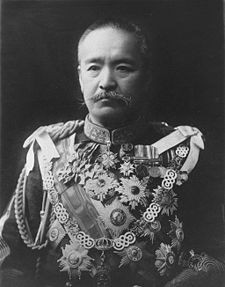 Infantry uniforms had red facings on tunic collars, shoulder straps and trouser stripes. Line infantry had yellow bands and piping on their caps while the infantry of the Imperial Guard were distinguished by red. Trouser seams for both branches of the infantry had wide red stripes. Artillery had yellow facings on their dark blue uniforms. The branch colour for engineers was dark brown, green for medical and light blue for transport units.
Infantry uniforms had red facings on tunic collars, shoulder straps and trouser stripes. Line infantry had yellow bands and piping on their caps while the infantry of the Imperial Guard were distinguished by red. Trouser seams for both branches of the infantry had wide red stripes. Artillery had yellow facings on their dark blue uniforms. The branch colour for engineers was dark brown, green for medical and light blue for transport units.
 A dark blue shako
A dark blue shako
(red for Imperial Guard units) was worn for full dress. The ordinary duty and active service headdress was however a form of peaked cap with a narrow crown, somewhat resembling the French kepi of the period.
A lightweight white cotton version was used for fatigue duties and tropical wear. In hot weather white trousers and cap covers were worn with the dark blue tunics.
 Senior officers could wear a longer, double-breasted version of the tunic in full dress. Other features included elaborate gold braiding on the cuffs according to rank, waist sashes, gold shoulder cords and plumes on the dress kepi.
Senior officers could wear a longer, double-breasted version of the tunic in full dress. Other features included elaborate gold braiding on the cuffs according to rank, waist sashes, gold shoulder cords and plumes on the dress kepi.
Cavalry regiments wore a short attila jacket with transverse hussar
style braiding in yellow (red for the cavalry of the Imperial Guard). Breeches were red. The cavalry branch colour was green and in 1905 this colour appeared on both collars and breeches stripes.
The dark blue uniform adopted under the 1886 Regulations was retained with only minor modifications until 1905. As such it was worn during the early months of the Russo-Japanese War
. A khaki summer uniform had been introduced shortly before the outbreak of war and this became general issue for front line infantry during June–August 1904. Cavalry and artillery were subsequently issued with the new khaki uniform but some second line units continued to wear dark blue until the end of the War in September 1905. During the winter of 1904-05 the heavier blue uniforms were again worn but often under the loose fitting summer khaki drill for camouflage.
Following the Russo-Japanese War the Japanese Army adopted khaki for all occasions - the first major army to discard colourful parade dress. Only the cavalry squadrons of the Imperial Guard and officers of all branches were authorised to retain their coloured uniforms for certain ceremonial and social occasions, until 1939.
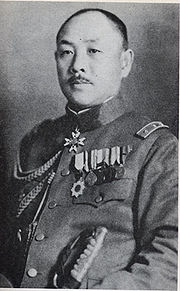
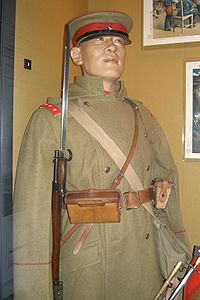 The 1911 uniform replaced the blue uniform. It was basically a yellowish-khaki
The 1911 uniform replaced the blue uniform. It was basically a yellowish-khaki
(called mustard
) colored version of the blue uniform. The new flat topped peaked cap had a red band, the tunic collar had swallow tailed red patches and the shoulders had red passant
s to indicate rank. The uniform was produced in wool for winter and cotton for summer wear.
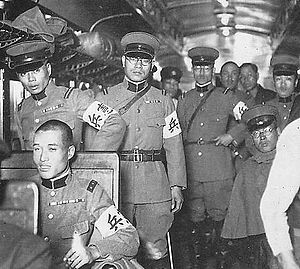 The Showa Type 5, also called the M90 or 2590 or 1930 uniform was basically the 1911 uniform but introduced internal breast pockets with scalloped pocket flaps on the tunic for all ranks. Also the straight trousers were later replaced with pantaloons which were worn with woolen spiral wound puttees and tapes.
The Showa Type 5, also called the M90 or 2590 or 1930 uniform was basically the 1911 uniform but introduced internal breast pockets with scalloped pocket flaps on the tunic for all ranks. Also the straight trousers were later replaced with pantaloons which were worn with woolen spiral wound puttees and tapes.
 The M98 (1938) was a further modification of the M90 uniform. The single breasted tunic had a stand and fall collar, five buttons which ran down the front and two, or more usually, four internal pockets with scalloped flaps (depending) on manufacturer. Long trousers or pantaloons were worn as standard along with the puttees and tapes. All except mounted troops (who wore breeches and high leather boots) wore this uniform with horsehide, pigskin or leather ankle-boots. The boots had either a hobnailed hard leather sole with metal heel J-cleat or a rubber sole with rubber cleats. When off duty, soldiers could wear tabi
The M98 (1938) was a further modification of the M90 uniform. The single breasted tunic had a stand and fall collar, five buttons which ran down the front and two, or more usually, four internal pockets with scalloped flaps (depending) on manufacturer. Long trousers or pantaloons were worn as standard along with the puttees and tapes. All except mounted troops (who wore breeches and high leather boots) wore this uniform with horsehide, pigskin or leather ankle-boots. The boots had either a hobnailed hard leather sole with metal heel J-cleat or a rubber sole with rubber cleats. When off duty, soldiers could wear tabi
s. A collarless wool or cotton white, grey or light green under shirt was worn under the tunic. This had one or two patch breast pockets with buttoned flaps, most had only a single pocket on the left breast. A khaki cotton shirt with stand and fall collar and two breast pockets could be worn in warm climates, with or without the tunic. The flat-topped peaked cap was replaced by a cloth field cap with a short leather or (more usually) cloth peak. Originally produced in khaki it was later produced in various shades of green ranging from grey-green to a dark green.
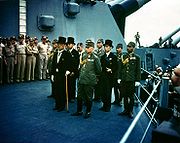 Officers were not usually issued uniforms so they had to procure their own, thus there was a wide variety in the details, colour and texture of their uniforms, with uniform colours ranging from tan to dark green. Collars were taller and stiffer and materials were of a higher quality. Senior officers could procure and wear a double-breasted version of the blue and M90 uniforms. All ranks wore a single breasted version of the M98. Officers could wear straight trousers with their M98 uniforms as a walking out uniform and later they could also wear the tunic with the collar open over a white or grey green shirt.
Officers were not usually issued uniforms so they had to procure their own, thus there was a wide variety in the details, colour and texture of their uniforms, with uniform colours ranging from tan to dark green. Collars were taller and stiffer and materials were of a higher quality. Senior officers could procure and wear a double-breasted version of the blue and M90 uniforms. All ranks wore a single breasted version of the M98. Officers could wear straight trousers with their M98 uniforms as a walking out uniform and later they could also wear the tunic with the collar open over a white or grey green shirt.
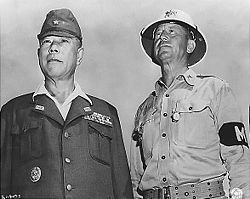 The IJA issued single-breasted over coats, capes and raincoats with hoods in olive drab.
The IJA issued single-breasted over coats, capes and raincoats with hoods in olive drab.
Uniform
A uniform is a set of standard clothing worn by members of an organization while participating in that organization's activity. Modern uniforms are worn by armed forces and paramilitary organizations such as police, emergency services, security guards, in some workplaces and schools and by inmates...
s of those countries who were the principal advisors to the Imperial Japanese Army
Imperial Japanese Army
-Foundation:During the Meiji Restoration, the military forces loyal to the Emperor were samurai drawn primarily from the loyalist feudal domains of Satsuma and Chōshū...
at the time.
1867 Blue uniform
The initial uniform colour was dark blue, following the contemporary French style and resembling that of the Union ArmyUniform of the Union Army
The Uniform of the Union Army was widely varied and, due to limitations on supply of wool and other materials, based on availability and cost of materials during the United States Civil War.- Generalization :The standard U.S...
of the American Civil War
American Civil War
The American Civil War was a civil war fought in the United States of America. In response to the election of Abraham Lincoln as President of the United States, 11 southern slave states declared their secession from the United States and formed the Confederate States of America ; the other 25...
.

1886 Blue Uniform
Resembling the Imperial German ArmyGerman Army (German Empire)
The German Army was the name given the combined land forces of the German Empire, also known as the National Army , Imperial Army or Imperial German Army. The term "Deutsches Heer" is also used for the modern German Army, the land component of the German Bundeswehr...
M1842/M1856 dunkelblau uniform, the dark blue single-breasted tunic
Tunic
A tunic is any of several types of clothing for the body, of various lengths reaching from the shoulders to somewhere between the hips and the ankles...
had a low standing collar and no pockets. It was worn with matching straight trousers
Trousers
Trousers are an item of clothing worn on the lower part of the body from the waist to the ankles, covering both legs separately...
and a kepi
Kepi
The kepi is a cap with a flat circular top and a visor or peak . Etymologically, the word is a borrowing of the French képi, itself a respelling of the Alemannic Käppi: a diminutive form of Kappe, meaning "cap"....
(red for Imperial Guard) on which was worn a brass five point star. After the Franco-Prussian War
Franco-Prussian War
The Franco-Prussian War or Franco-German War, often referred to in France as the 1870 War was a conflict between the Second French Empire and the Kingdom of Prussia. Prussia was aided by the North German Confederation, of which it was a member, and the South German states of Baden, Württemberg and...
the kepi was replaced with a flat topped peaked cap and the tunic collar became higher. Pockets were added to officers' tunics late in its issue.


Shako
A shako is a tall, cylindrical military cap, usually with a peak or visor and sometimes tapered at the top...
(red for Imperial Guard units) was worn for full dress. The ordinary duty and active service headdress was however a form of peaked cap with a narrow crown, somewhat resembling the French kepi of the period.
A lightweight white cotton version was used for fatigue duties and tropical wear. In hot weather white trousers and cap covers were worn with the dark blue tunics.

Cavalry regiments wore a short attila jacket with transverse hussar
Hussar
Hussar refers to a number of types of light cavalry which originated in Hungary in the 14th century, tracing its roots from Serbian medieval cavalry tradition, brought to Hungary in the course of the Serb migrations, which began in the late 14th century....
style braiding in yellow (red for the cavalry of the Imperial Guard). Breeches were red. The cavalry branch colour was green and in 1905 this colour appeared on both collars and breeches stripes.
The dark blue uniform adopted under the 1886 Regulations was retained with only minor modifications until 1905. As such it was worn during the early months of the Russo-Japanese War
Russo-Japanese War
The Russo-Japanese War was "the first great war of the 20th century." It grew out of rival imperial ambitions of the Russian Empire and Japanese Empire over Manchuria and Korea...
. A khaki summer uniform had been introduced shortly before the outbreak of war and this became general issue for front line infantry during June–August 1904. Cavalry and artillery were subsequently issued with the new khaki uniform but some second line units continued to wear dark blue until the end of the War in September 1905. During the winter of 1904-05 the heavier blue uniforms were again worn but often under the loose fitting summer khaki drill for camouflage.
Following the Russo-Japanese War the Japanese Army adopted khaki for all occasions - the first major army to discard colourful parade dress. Only the cavalry squadrons of the Imperial Guard and officers of all branches were authorised to retain their coloured uniforms for certain ceremonial and social occasions, until 1939.
1904 Enlisted Khaki uniform
This was basically a khaki cotton version of the 1886 uniform with a shorter jacket.1911


Khaki
This article is about the fabric. For the color, see Khaki . Kaki, another name for the persimmon, is often misspelled "Khaki".Khaki is a type of fabric or the color of such fabric...
(called mustard
Mustard (color)
Mustard is a color that resembles culinary mustard. It is similar to the color Flax.-Mustard in human culture:Food* Mustard is the color of the belt awarded to the winner of the Nathan's Hot Dog Eating Contest at Nathan's Famous in Coney Island, New York.Games*In the board game Cluedo, one of the...
) colored version of the blue uniform. The new flat topped peaked cap had a red band, the tunic collar had swallow tailed red patches and the shoulders had red passant
Passant
Passant may refer to:* In heraldry, an attitude.* The en passant chess move of a pawn* A transverse shoulder strap on a military uniform, originally to attach epaulettes...
s to indicate rank. The uniform was produced in wool for winter and cotton for summer wear.
5shiki Gun-i/Type 5

98shiki Gun-i/Type 98

Tabi
are traditional Japanese socks. Ankle-high and with a separation between the big toe and other toes, they are worn by both men and women with zori, geta, and other traditional thonged footwear. Tabi are also essential with traditional clothing—kimono and other wafuku as well as being worn by...
s. A collarless wool or cotton white, grey or light green under shirt was worn under the tunic. This had one or two patch breast pockets with buttoned flaps, most had only a single pocket on the left breast. A khaki cotton shirt with stand and fall collar and two breast pockets could be worn in warm climates, with or without the tunic. The flat-topped peaked cap was replaced by a cloth field cap with a short leather or (more usually) cloth peak. Originally produced in khaki it was later produced in various shades of green ranging from grey-green to a dark green.
3shiki Gun-i/Type 3
The Type 3 Officers Uniform, was introduced in 1943 and was similar to the Type 98 but was made of cheaper materials. It also reintroduced cuff insignias for officers. It was produced in various shades of green. Officers could wear the uniform tunic open over a white or light green shirt and black or green tie.Officers Uniforms

Helmets
- Adrian helmet - As with many countries, the IJA adopted and produced the French Adrian helmetAdrian helmetThe M15 Adrian helmet was a combat helmet issued to the French Army during World War I. It was the first standard helmet of the French Army and was designed when millions of French troops were engaged in trench warfare, and head wounds became a frequent cause of battlefield casualties...
. - Type 92 - The Adrian helmet was later replaced by a Japanese designed helmet called the Type 92 (1932). It was officially called tetsubo (steel cap) but was called tetsukabuto (Steel Helmet) by troops. It was made in the shape of a dome with a short protruding rim all the way around it (the paratroop version only had a short brim in the front). This helmet was made of a thin inferior chrome-molybdenumMolybdenumMolybdenum , is a Group 6 chemical element with the symbol Mo and atomic number 42. The name is from Neo-Latin Molybdaenum, from Ancient Greek , meaning lead, itself proposed as a loanword from Anatolian Luvian and Lydian languages, since its ores were confused with lead ores...
steel with many proving to be very fragile, being easily pierced by shrapnel and/or gunfire. A star (or anchor for the IJN) was solderSolderSolder is a fusible metal alloy used to join together metal workpieces and having a melting point below that of the workpiece.Soft solder is what is most often thought of when solder or soldering are mentioned and it typically has a melting range of . It is commonly used in electronics and...
ed to the front and the helmet and star were painted mustard khaki. They were sometimes whitewashed in the winter. A tanTan (color)Tan is a pale whiteish, tawny shade of white. The name is derived from tannum used in the tanning of leather.The first recorded use of tan as a shade name in English was in the year 1590....
, khakiKhakiThis article is about the fabric. For the color, see Khaki . Kaki, another name for the persimmon, is often misspelled "Khaki".Khaki is a type of fabric or the color of such fabric...
or olive-green two layer, fiber reinforced linen cover was available with a yellow star sewn on the front. The helmet was secured to the head by an elaborate set of straps descended from those of the KabutoKabutoA kabuto is a helmet used with traditional Japanese armour as worn by the samurai class and their retainers in feudal Japan....
samuraiSamuraiis the term for the military nobility of pre-industrial Japan. According to translator William Scott Wilson: "In Chinese, the character 侍 was originally a verb meaning to wait upon or accompany a person in the upper ranks of society, and this is also true of the original term in Japanese, saburau...
helmet. It was also able to be worn over a reversed field cap. Camouflage nets were widely worn over the helmet especially in the Southern theatre and Pacific island campaign. - Tropical helmetPith helmetThe pith helmet is a lightweight cloth-covered helmet made of cork or pith...
-- Type 90 - was like the cork helmet issued by the European imperial powers. It had a metal ventilator at the top, a couple of ventilation eyelets on either side and a brown leather chinstrap. It was mostly worn by officers.
- Type 92 - This was a cork version of the Type 92 steel helmet. It was covered with six segments of cloth, and several versions were available. It was issued to all ranks. Officers usually wore a white cover on theirs. A similar helmet was worn by the Viet Cong.
Other Items

- SenninbariSenninbariA or Thousand stitch belt is a strip of cloth, approximately one meter in length, decorated with 1000 stitches, given as an amulet by women to soldiers on their way to war as a part of the Shinto culture of Imperial Japan.-Construction, and types:...
were a red-sash 1,000 stich belt worn around the waist of their uniforms. They were supposed to bring good luck, confer courage, and make the wearer immune from bullets. - HachimakiHachimakiA hachimaki is a stylized headband in Japanese culture, usually made of red or white cloth, worn as a symbol of perseverance or effort by the wearer. These are worn on many occasions, for example, by sports spectators, by women giving birth, students in cram school, office workers, expert...
(鉢巻) is a stylized headbandHeadbandA headband is a clothing accessory worn in the hair or around the forehead, usually to hold hair away from the face or eyes. Headbands generally consist of a loop of elastic material or a horseshoe-shaped piece of flexible plastic or metal...
(bandanaBandanaBandana can refer to:*Another name for a kerchief*Bandana *Bandana *Bandana, Kentucky, a small town in the United States*Y Bandana, a Welsh alternative rock band.**Y Bandana , their self-titled debut album....
) in the Japanese cultureCulture of JapanThe culture of Japan has evolved greatly over the millennia, from the country's prehistoric Jōmon period to its contemporary hybrid culture, which combines influences from Asia, Europe and North America...
, usually made of red or white cloth, worn as a symbol of perseverancePerseverancePerseverance may refer to:* Perseverance , a card game* Perseverance , American fighter Brock Lesnar* Perseverance...
or effort by the wearer. - FatiguesBattledressBattledress, or fatigues in the general sense, is the type of uniform used as combat uniforms, as opposed to 'display' dress or formal uniform worn at parades and functions. It may be either monochrome or in a camouflage pattern...
- White cotton fatigues were initially issued as a tropical uniform but then when a light-khaki(tan) was adopted as a hot weather uniform colour, the fatigues were worn over the standard uniform to keep it clean while doing dirty-work. Later an olive green version of the white fatigues was issued. - Bousyo-i/Tropical - The tropical cotton uniform, designed similar to the M98, were initially available in tan or light khaki, but were superseded later in the war by versions in medium to dark green. They had open collars, buttoned side vent flaps below the armpits, pleated patch or internal pockets with flaps. Trousers could be full-length, 3/4 length, or a loose fitting breechesBreechesBreeches are an item of clothing covering the body from the waist down, with separate coverings for each leg, usually stopping just below the knee, though in some cases reaching to the ankles...
style pantaloonPantaloonPantaloon or Pantaloons may refer to:*Pantaloons, a style of trousers*Pantaloon Retail India, a large retailer in India*The Pantaloons, an English touring theatre company*Pantaloon, a character in the Harlequinade-See also:...
. The usual uniform worn in the Pacific islands was knee length shorts worn with a lightweight cotton shirt, which had three front buttons, 3/4 length sleeves and patch breast pockets with flaps. Officers wore a short or long sleeved lightweight white (or off-white) tropical shirt with the green trousers. When they wore the green tropical tunic they usually wore the shirt collar outside and over the tunic collar. - Kessenfuku/Battle Dress - A waist length jacket with two hidden slash breast pockets, and two internal pockets with flaps. It also had a fold-down collar and reinforced elbows. Cheaper materials were used in fabrication with many variations in material and color.
- Imperial GuardImperial Guard of JapanThe Japanese is an organization which is dedicated to protection of the Emperor of Japan and his family, palaces and other imperial properties. Following the end of World War II the traditional Guard, which also served as a unit in the Imperial Japanese Army, was dissolved and in 1947 a civil...
- Until 1939 the Cavalry of the Imperial Guard wore a French style parade uniform consisting of a dark-blue tunicTunicA tunic is any of several types of clothing for the body, of various lengths reaching from the shoulders to somewhere between the hips and the ankles...
with red Brandenburg braiding, a red kepiKepiThe kepi is a cap with a flat circular top and a visor or peak . Etymologically, the word is a borrowing of the French képi, itself a respelling of the Alemannic Käppi: a diminutive form of Kappe, meaning "cap"....
and red breechesBreechesBreeches are an item of clothing covering the body from the waist down, with separate coverings for each leg, usually stopping just below the knee, though in some cases reaching to the ankles...
. The red kepi had a white plumeHackleThe hackle is a clipped feather plume that is attached to a military headdress.In the British Army and the armies of some Commonwealth countries the hackle is worn by some infantry regiments, especially those designated as fusilier regiments and those with Scottish and Northern Irish origins. The...
with a red base. Off duty, a dark blue tunic with 5 rows of black mohair froggings with dark blue breeches with a red stripe down each seam, were worn. Prior to the general adoption of khaki by the Japanese Army after the Russo-Japanese War (1904–1905) an all white linenLinenLinen is a textile made from the fibers of the flax plant, Linum usitatissimum. Linen is labor-intensive to manufacture, but when it is made into garments, it is valued for its exceptional coolness and freshness in hot weather....
uniform had been worn in hot weather. The Infantry of the Imperial Guard wore a dark blue uniform with white leggings for both parade and service wear until 1905. It was distinguished from that of the line infantry by a red band and piping on the peaked service cap (instead of yellow). Following the adoption of a khaki service dress the Guard Infantry wore this on all occasions. In the field the army's basic uniform was worn. It was worn with either a chrysanthemumChrysanthemumChrysanthemums, often called mums or chrysanths, are of the genus constituting approximately 30 species of perennial flowering plants in the family Asteraceae which is native to Asia and northeastern Europe.-Etymology:...
or a star in a wreath. - Shin guntōShin guntoThe was a weapon and badge of rank used by the Imperial Japanese Army between the years of 1935 and 1945. During most of that period, the swords were manufactured at the Toyokawa Naval Arsenal.- Creation of a new army sword :...
- The shin guntō (新軍刀?, "New Army Sword") was a weapon and badge of rank used by the Imperial Japanese Army between the years of 1935 and 1945.
External links
- Imperial Japanese Army 3rd Platoon reenactor's resource
- http://www.diggerhistory.info/pages-uniforms/japanese.htm
- http://www.diggerhistory.info/pages-uniforms/japanese2.htm

